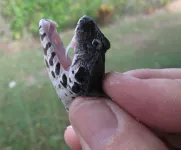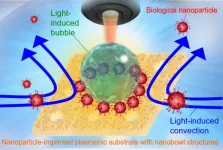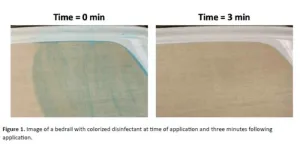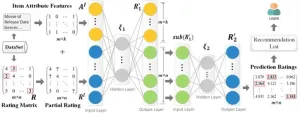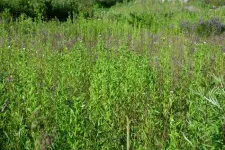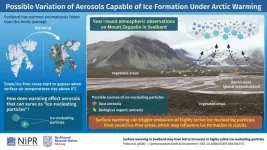(Press-News.org) Only about ten percent of the world’s roughly 4,000 snake species have venom strong enough to seriously hurt a human, but that’s enough for snake bites to be an important public health concern. To help better understand how snakes make their venom and how venoms differ from one species to another, researchers developed a new way to zero in on the genes that snakes use in venom production. Their work was published in the journal Molecular Ecology Resources.
“We’ve developed a tool that can tell us which venom-producing genes are present across an entire snake family in one fell swoop,” says Sara Ruane, the Assistant Curator of Herpetology in the Field Museum’s Negaunee Integrative Research Center and the study’s senior author.
All living things contain DNA, a molecule that provides chemical instructions for building and operating an organism’s body. These instructions are called a genome, and smaller sections of the genome are called genes. The human genome, for instance, is made up of about 20,000 genes, which contain instructions for everything from cell growth to eye color.
In snakes, there are thousands of genes involved with producing venom, and different species of venomous snakes use different combinations and versions of those genes to produce their toxins.
“It’s important to know what’s in a snake’s venom, because different kinds of venom do different things-- some venoms affect the nervous system, some affect the circulatory system, some affect cell function,” says Ruane. “Knowing what’s in a certain kind of venom can help in the development of antivenom for treating that kind of snakebite.”
What’s more, there are compounds in snake venoms that are actually used in pharmaceutical development and human medicine-- for instance, the first ACE-inhibitor drug for treating high blood pressure was created from a compound found in the venom of a Brazilian pit viper. “You can harness the power of death in a controlled way,” says Ruane.
Since there are thousands of genes that produce venom and each snake’s genome contains tens of thousands of genes, it can be difficult to zero in on the ones present for venom production in a given species. To solve this problem, Ruane and her colleagues, led by the study’s first author, Scott Travers, developed a technique called VenomCap.
VenomCap is a set of exon-capturing probes, which are groups of molecules designed to interact with a specific group of genes. VenomCap was designed to bind with any of the several thousands of genes that previous studies have shown are involved with venom production in snakes. Rather than having to sequence a snake’s entire genome (a lengthy and expensive process) and combing through it for 2,000+ possible venom-making genes, VenomCap could provide a quicker, easier means for scientists to see which of these genes a snake possesses.
To test VenomCap’s ability to bind with venom-producing genes, the researchers took tissue samples from 24 kinds of snakes across the medically important family Elapidae, which includes cobras, mambas, and coral snakes. Previous genomic studies have already shown many of the venom-producing genes these snakes have, and VenomCap was able to match those results, on average, with 76% accuracy. VenomCap can be used with previously collected tissues from anywhere in a snake’s body, rather than needing to come from the venom glands directly, which is another frequently used technique for determining venom genes in snakes.
Since VenomCap can be used to analyze venom genes from individual species across the whole elapid family (about 400 species), it may make it easier for scientists to study the relationships between these snakes’ lifestyles and the venoms they produce. “Let’s say you’re interested in some closely-related species of snakes that look different from each other, live in different environments, and eat different things. VenomCap could help scientists compare the venoms that these snakes produce, and that could help answer bigger-picture questions of whether venoms evolve to match the snakes’ lifestyles, or if their lifestyles evolve to match the venom they produce,” says Ruane.
In addition to shining a light on snake evolution, a tool like VenomCap could make a difference for scientists trying to treat dangerous snake bites. “Snake bite is considered a neglected disease on the global-scale. In the United States, we don’t come into contact with venomous snakes that often, and when we do, we have extremely good medical treatment-- if you expeditiously go to the hospital with a snakebite, you are almost certainly not going to die,” says Ruane. “But in other parts of the world, a hospital might be too far away to reach in time, or they might not have the right kind of antivenom on hand, because antivenom is in very short supply. So any kind of work that looks at snake venom and helps us identify the venoms present in different species can be extremely important to provide baseline data for developing effective treatments.”
###
END
Zeroing in on the genes that snakes use to produce venom
2024-09-19
ELSE PRESS RELEASES FROM THIS DATE:
Maynooth University study reveals impact of homework on student achievement in maths and science
2024-09-19
· Daily homework of up to 15 minutes most effective for maths achievement
· Homework assigned three to four times a week benefits science performance
· Short duration homework just as effective as longer assignments
Researchers at Maynooth University’s Hamilton Institute and Department of Mathematics and Statistics in Ireland have unveiled significant findings on the role of homework in student achievement. The research, led by Prof Andrew Parnell, Nathan McJames and Prof Ann O’Shea, used a new AI model to analyse data from the Trends in International Mathematics and Science ...
Reducing floodplain development doesn’t need to be complex
2024-09-19
A new paper in Oxford Open Climate Change, published by Oxford University Press, uncovers evidence suggesting that, contrary to expectations, most U.S. cities are not doing too badly in avoiding development in areas prone to flooding, and those that are effective appear to be applying existing tools and strategies well, rather than doing anything particularly novel.
Despite billions of dollars of investments and widespread mitigation efforts, the costs of disasters in the United States have grown dramatically. ...
Lights, camera, action! Coronavirus spike proteins can be selectively detected in 5 minutes
2024-09-19
Like moths to a flame, microbes can also be moved by light. Using this knowledge, researchers from Osaka Metropolitan University’s Research Institute for Light-induced Acceleration System (RILACS) have demonstrated a method to detect the presence of viruses quickly and using only a small sample.
The research team led by OMU Professor Takuya Iida, the director of RILACS, and Associate Professor Shiho Tokonami, the deputy director, report in npj Biosensing on a light-induced immunoassay. Using ...
Your Zoom background could influence how tired you feel after a video call
2024-09-19
Part of many people’s pandemic experience included working from home. Even after lockdowns, videoconferencing remains a big part of life as people continue to work remotely, connect with families and friends online, and attend virtual events hosted on videoconferencing platforms.
Spending hours on video calls, however, can be exhausting and manifest as physical, emotional, or cognitive tiredness – a phenomenon known as videoconferencing fatigue (VF). Now, researchers in Singapore have asked if a relationship between virtual backgrounds and VF exists and ...
With the use of visual cues, hospital rooms get nearly 70% cleaner
2024-09-19
With the Use of Visual Cues, Hospital Rooms Get Nearly 70% Cleaner
New study shows that a simple color additive in disinfectant wipes dramatically improved room cleanliness and even reduced time needed for cleaning
Arlington, Va. — September 19, 2024 — A new study published today in the American Journal of Infection Control (AJIC) reports a comparison of hospital room cleanliness using standard disinfectant wipes versus wipes with a color additive that allows users to see which surfaces have been sanitized. With the color additive, rooms ...
Serial-autoencoder for personalized recommendation
2024-09-19
In the last decade, auxiliary information has been widely used to address data sparsity. Due to the advantages of feature extraction and the no-label requirement, autoencoder-based methods addressing auxiliary information have become quite popular. However, most existing autoencoder-based methods discard the reconstruction of auxiliary information, which poses a huge challenge for better representation learning and model scalability.
To solve the problems, a research team led by Zhu YI published their new research on 15 August 2024 in Frontiers of Computer Science co-published by Higher Education Press and Springer Nature.
The team proposed a novel representation ...
How do look for microbes in nature that are beneficial to plant?
2024-09-19
Cucumber is a common vegetable on people’s table because of its crisp and refreshing characteristics. In order to meet the market demand throughout the year, cucumber is now mainly planted in facility greenhouses. However, the loss of soil nutrients and the accumulation of pathogenic microorganisms are inevitable in successive years of cultivation. Cucumber corynespora leaf spot, also known as cucumber target spot disease, is a major foliar disease that causes cucumber yield reduction, and its pathogen is the Corynespora cassiicola. The pathogen harms cucumber leaves, causing irregular spots and affecting the photosynthesis ...
Exotic species invasions enhance biodiversity response to climate change
2024-09-19
Globally, more than 13,000 plant species, equivalent to the entire native flora of Europe, have been naturalized outside their native ranges. A recent study, jointly conducted by scientists from China and the USA, has provided new insights about biodiversity, exotic invasion, and their relationship to climate change.
Published in Nature Plants, the research uncovers the climatic niche mechanisms that shape both the vulnerability of native ecosystems and the invasiveness of exotic species in a warming world.
A long-standing debate exists over the impact of exotic species on native ecosystems and ...
Arctic warming may fuel ice formation in clouds
2024-09-19
The Arctic frequently experiences temperatures that support the formation of mixed-phase clouds that contain supercooled liquid droplets and ice crystals. The composition of such clouds plays a crucial role in the region's energy balance and climate system. Clouds with more liquid last longer and reflect more sunlight than those with more ice crystals.
With Arctic warming, meteorologists have been interested in determining the effect of rising temperatures on cloud composition and its broader effect on the region. Climate models generally predict that as the Arctic warms, clouds in the region will ...
Rugged Falklands landscape was once a lush rainforest
2024-09-19
A researcher from the University of Southampton (UK) has found evidence that the treeless, rugged, grassland landscape of the Falkland Islands was home to a lush, diverse rainforest up to 30 million years ago.
A study by Dr Zoë Thomas, leading an international team of scientists, reveals that the South Atlantic archipelago was once covered in cool, wet woodland – similar to the present day rainforests found in Tierra del Fuego, off the tip of South America.
The scientists conducted the research after clues to the whereabouts of buried remains of the ancient forest reached them via word-of-mouth in the tight knit community of Port Stanley, the Falklands’ ...
